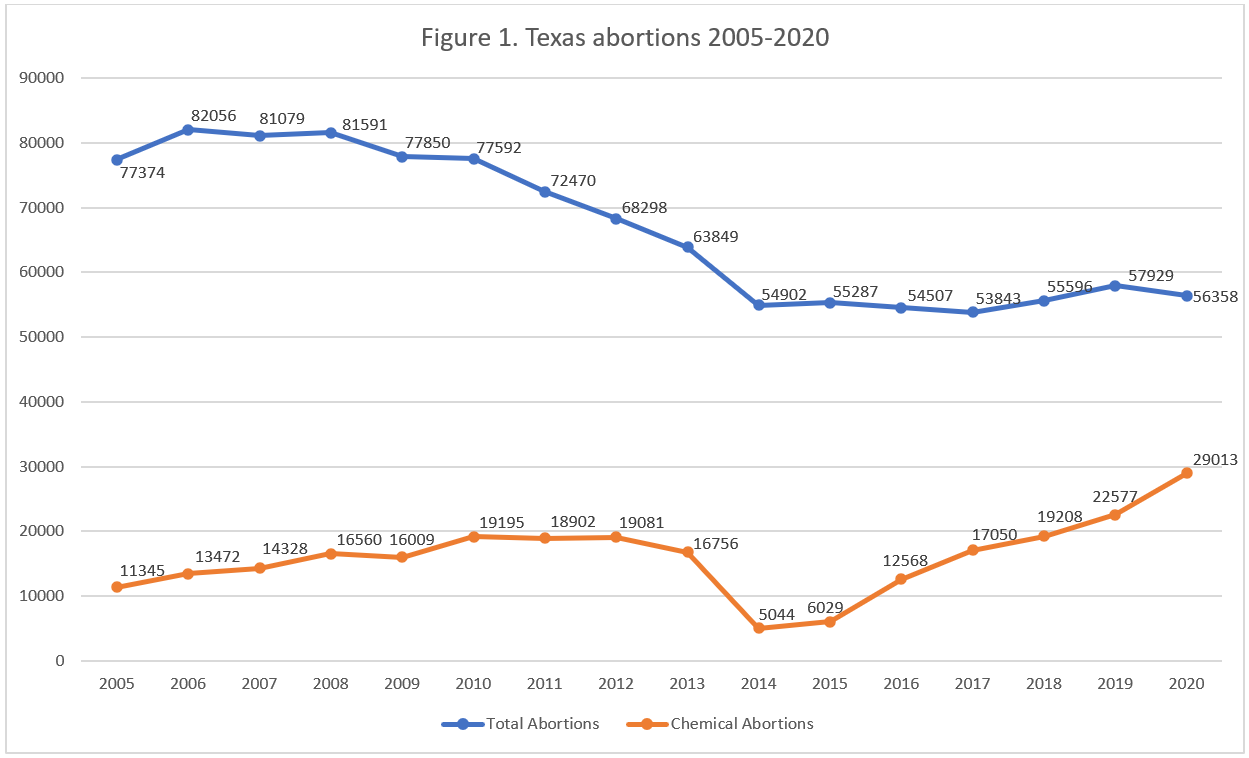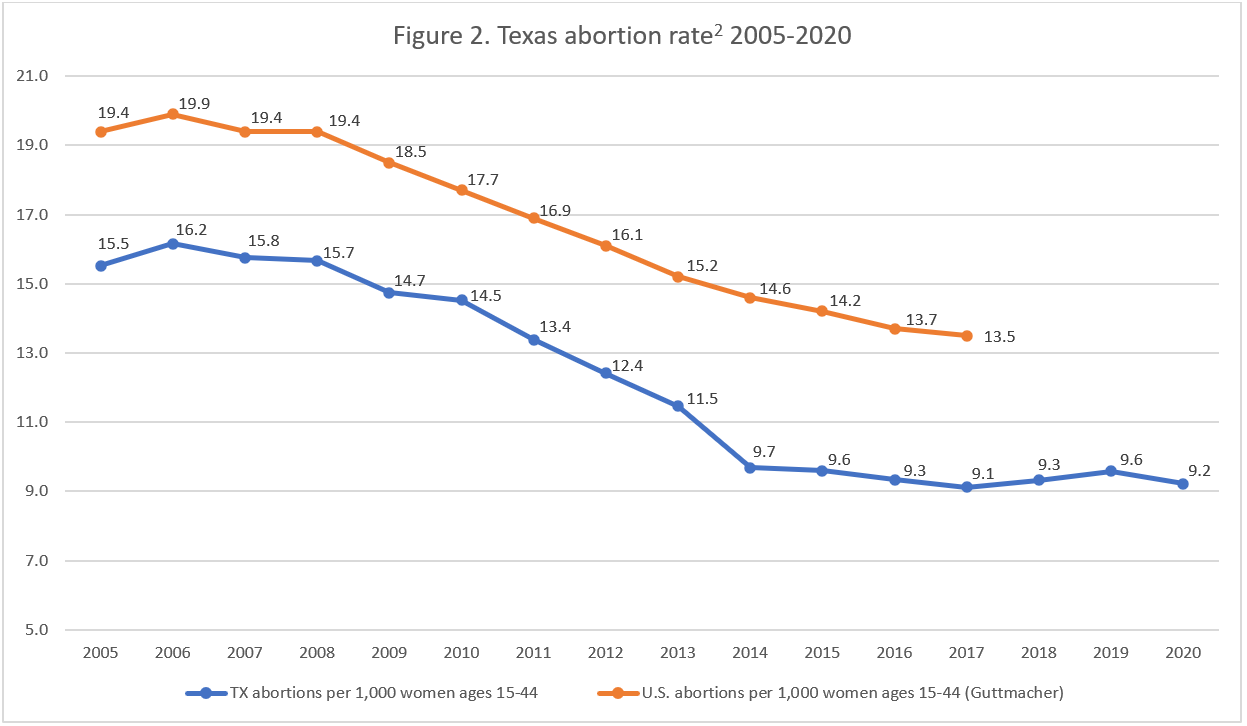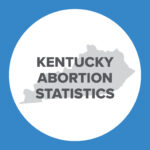Abortion Reporting: Texas (2020)
Texas’ 2020 report was released by Texas Health and Human Services in September 2021, reporting a sharp drop in abortions in early 2020.
Changes in Texas Abortions, 2019-2020

The report does not include information on Planned Parenthood’s Texas abortion market share.
Abortion Totals and Trends
In 2020, there were 56,358 Texas abortions reported, a drop of almost three percent from 2019 (Fig. 1). However, chemical abortions increased by 29 percent, making up over half of Texas abortions in 2020. The Charlotte Lozier Institute (CLI) estimates that Texas’ abortion rate fell four percent to 9.2 abortions per 1,000 women ages 15 to 44 (Fig. 2). As of March 2022, 29 states had released 2020 abortion statistics, of which 19 reported that abortions had increased from 2019.
State Report Summary
Texas abortions include abortions performed in Texas on residents and nonresidents, as well as abortions performed on Texas residents in other states. In 2020, 96 percent of Texas abortions were performed on state residents in Texas, two percent were performed on nonresidents in Texas, and another two percent were performed on Texas women in other states.
In 2020, nine percent of Texas abortions were performed on girls under the age of 20. Thirty percent of the abortions were obtained by women ages 20 to 24, and 29 percent were performed on women ages 25 to 29. Nineteen percent of the abortions were performed on women ages 30 to 34 and 11 percent on women ages 35 to 39. Four percent were performed on women ages 40 and older.
Hispanic women made up the largest group of women undergoing Texas abortions, composing 36 percent of the total. Thirty percent of the abortions were on black women, and 26 percent were on white women. Five percent of Texas abortions were performed on Asian women, 0.3 percent were on Native American women, and one percent were on women of other races. Race was not reported for one percent of the abortions. CLI estimates that Texas’ black abortion rate was 20.1 abortions per 1,000 women ages 15 to 44, three times the white rate of 6.6, while the Hispanic abortion rate was 7.7.
Over half of Texas abortions were chemical (51 percent). Forty-four percent were suction curettage procedures, and five percent were conducted via dilation and evacuation. There were 33 sharp curettage abortions (.06 percent) and one hysterotomy or hysterectomy abortion. The type of procedure was not reported for 0.3 percent of the abortions.
A majority of Texas abortions, 84 percent, occurred before nine weeks post-fertilization (approximately 11 weeks of gestation). Six percent were performed between nine and 10 weeks post-fertilization, and four percent were reported between 11 and 12 weeks. Three percent of Texas abortions occurred between 13 and 14 weeks post-fertilization, one percent between 15 and 16 weeks, and another one percent from 17 to 20 weeks. There were eight abortions reported between 21 and 24 weeks post-fertilization (23 to 26 weeks of gestation); no abortions were reported at 25 weeks post-fertilization or later.
More than half of Texas abortions (53 percent) were performed in licensed abortion facilities, and 45 percent were reported by ambulatory surgery centers. There were 71 abortions performed in hospitals (0.1 percent), while zero abortions were reported to have occurred in physician’s offices. Two percent of Texas abortions occurred out-of-state.
Texas’ 2020 abortion report was the third to include information collected under the state’s new complication reporting law.1 Both abortion physicians and facilities are required to report abortion complications, and these complications are displayed in two separate tables in the abortion report. Texas Health and Human Services removes duplicate reports within each table, but because physicians and the facilities in which they operate are both required to report complications, complications are duplicated across both tables.
In 2020, Texas received 233 complication reports from facilities, including three duplicate forms. Multiple complications can be reported on each form, and multiple forms could potentially be submitted for a single patient or complication. As required by its reporting law, Texas removes duplicate reports from its complication tables. There were 263 unduplicated complications reported by facilities. The most frequent complication was incomplete abortion, which occurred 102 times. There were 37 cases of hemorrhage and 21 infections. Zero born-alive babies were reported in 2020. For the first time in over a decade, an abortion-related death was reported in October of 2020.
Some of the tables in the report contain information for abortions performed on Texas residents only; abortions performed in Texas on nonresident women are not included. In 2020, 84 percent of the abortions obtained by Texas residents were performed on unmarried women, while 16 percent were performed on married women. Thirty-nine percent of Texas resident abortions were performed on women with no previous live births. Twenty-four percent were on women with one prior live birth, and 37 percent were on women with two or more previous births. Sixty-three percent of Texas resident abortions were obtained by women who reported no previous abortions, 24 percent were performed on women with one prior abortion, and 13 percent were obtained by women with more than one previous abortion.
In March and April of 2020, all non-medically necessary procedures, including abortions, were postponed due to the pandemic. Compared to 2019 monthly totals, Texas in-state resident abortions were 23 percent lower in March and 41 percent lower in April. However, the total number of in-state resident abortions performed between May and December was nearly three percent higher in 2020 than in 2019.
Because not every state shares abortion data with Texas, some abortions performed on Texas residents in other states are not included in the Texas abortion report. Research analyzing abortions performed on Texas residents in Arkansas, Colorado, Kansas, Louisiana, Oklahoma, and New Mexico between February and May 2021 found that out-of-state Texas resident abortions increased. Even with this increase, though, Texas’ abortion total was still lower in early 2020 compared to the previous year.
Texas Heartbeat Act
In 2020, Texas enacted the Texas Heartbeat Act to limit abortion when the unborn baby’s heartbeat can be detected, which occurs around six weeks of gestation. The Texas Heartbeat Act went into effect on September 1, 2021. An initial survey from the Texas Policy Evaluation Project (TxPEP) suggested that the Heartbeat Act ultimately could prevent 84 percent of Texas abortions, while Texas abortion providers asserted that 85 to 90 percent of all abortions could be averted. A follow-up report from TxPEP predicted that abortions would immediately drop by 50 percent, with even greater declines the longer the law remains in effect.
As of March 2022, Texas Health and Human Services had released abortion data from September and October 2021, the first two months the law was in effect. Abortions in Texas have decreased by over 50 percent compared to the same month in the previous year.
State Ranking
In CLI’s 2016 paper evaluating abortion reporting across the country, Texas’ reporting tied for 15th best. To improve its reporting, Texas could report post-fertilization age with more precision, allowing Texans to determine how many abortions occurred at six weeks of gestation or later, whereas currently all abortions earlier than nine weeks post-fertilization are reported as one total. Texas could also report the states from which it did or did not receive data on abortions performed on Texas women.
-
- Statistics on abortion complications reported here represent a minimal number of deaths and complications, as this data is collected in a non-systematic and non-verifiable way. As such, this data cannot be used to calculate either an accurate abortion mortality rate or an accurate abortion complication rate for the state.
- Rates were calculated by CLI using the following formula: (total number of Texas abortions ÷ number of resident women ages 15-44) x 1,000. Rates may differ slightly from previous CLI articles due to revised population estimates. Population estimates were obtained from the CDC WONDER database.



























